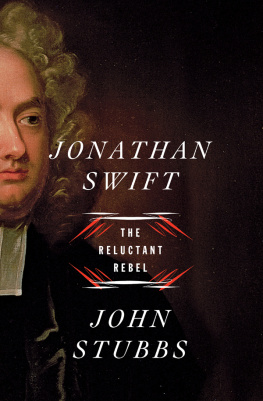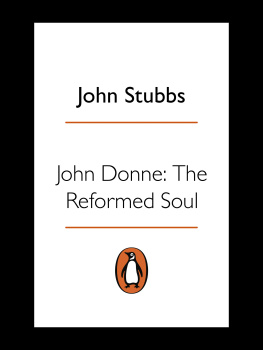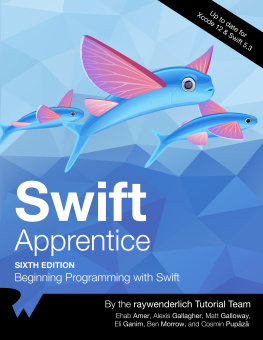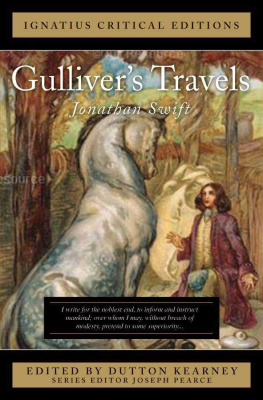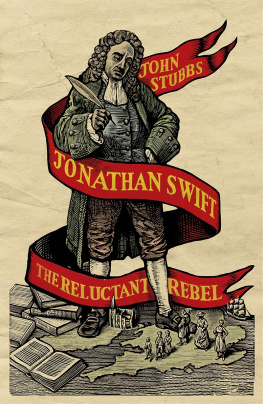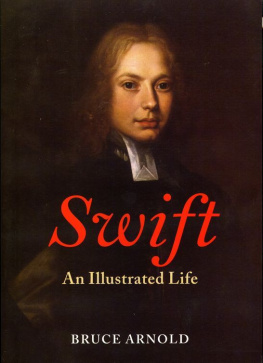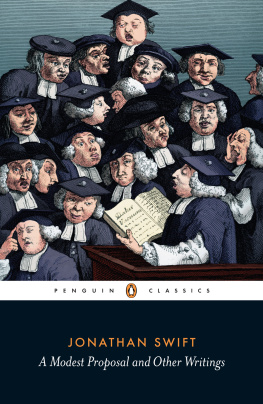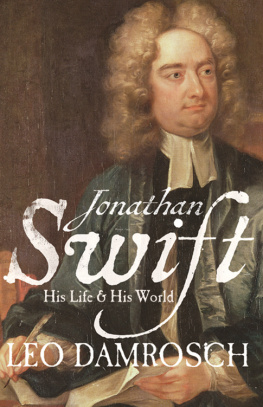
BY THE SAME AUTHOR
Donne: The Reformed Soul
Reprobates: The Cavaliers of the English Civil War
JONATHAN SWIFT
The Reluctant Rebel
John Stubbs

W. W. NORTON & COMPANY
Independent Publishers Since 1923
New York London
Only one Thing I know, that the cruel Oppressions of this
Kingdom by England are not to be borne.
Swift, writing to Benjamin Motte, 25 May 1736
Contents
Atrocity propaganda from James Cranford, The Teares of Ireland (1642) ( The British Library Board, G.5557, p. 75)
An Irish Cabin from Arthur Young, A Tour in Ireland (1780) ( The Granger Collection, New York)
A wild Irish man and woman from John Speeds Map of the Kingdom of Ireland (1616) ( The British Library Board, Maps C.7.c.19, title page)
The Battle of the Boyne by Jan Wyck (1693)
South-east view of St Patricks Cathedral, by W. Smith (nineteenth century) ( National Gallery of Ireland)
The High Street and Market Cross, Kilkenny, printed in John G. A. Prim, The Market Cross of Kilkenny, Transactions of the Kilkenny Archaeological Society , 2, 2 (1853) ( The British Library Board, Ac.5785)
Swift, by or after Charles Jervas (170910) ( National Portrait Gallery, London)
Sir William Temple, by Gaspar Netscher (1675) ( National Portrait Gallery, London)
Portrait of a young woman, possibly Esther Johnson (early eighteenth century) (Photo National Gallery of Ireland)
Portrait of a young woman, possibly Esther (or Hester) Vanhomrigh, attributed to Charles Jervas (early eighteenth century) (Photo National Gallery of Ireland)
Alexander Pope, by or from the studio of Michael Dahl ( c .1727) ( National Portrait Gallery, London)
Swift, by Isaac Whood (1730) (Photo National Gallery of Ireland)
North prospect of St Patricks Cathedral, by Jonas Blaymires ( Representative Church Body)
Swifts Travels , frontispiece from the first edition ( Gullivers Travels by Jonathan Swift, 1726 (engraving), English School, eighteenth century, private collection/Bridgeman Images)
With a few exceptions, dates are given according to New Style, i.e. following a calendar in which the year begins on 1 January rather than on Lady Day (25 March). Quotations from Swift, his contemporaries and earlier writers are selectively modernized: that is, in practice, I have minimized the frequent italics in eighteenth-century printed literature, and occasionally altered punctuation for the sake of intelligibility. At the same time I have tried to preserve the feel of an early edition of Swift as much as possible. This has involved retaining for the most part contemporary spellings and the convention of capitalizing the initial letters of key words in the text.
One midsummer night in Dublin, 1710, two students made their way from a tavern in the heart of the old city back to the enclosure of Trinity College. They were in breach of the college curfew and, quite contrary to the former course of their lives, as they protested later, had taken drink. The two undergraduates, Graffon and Vinicome, fell into company with a dubious character they knew called Harvey. For a lark, he suggested they get up on to the statue of the late King, which stood proudly on the wide street in front of the college.
At this hour the hub was quiet if not deserted. The shops on Dame Street and the warehouses in the alleyways had long been shut up for the night. The elegant, modestly Baroque front of Trinity was darkened. Across College Green to the north, also in shadows, stood Chichester House, where the Irish Parliament usually sat. It was an old building in a state of poor repair much, it might have been said, like the Parliaments it hosted. The Irish Lords and Commons had little power, and often little wish, to argue with orders from London. The record does not show whether the three hi-jinksers had an audience. They might have had a spectator or two in a passer-by, from one of the high-gabled houses at the rim of the green, or from a college window in Trinitys wide complex. In theory, a porter should have been standing on duty at the gate, looking out for those haunting the town. The tipsy students were dressed in the plain, dark, inexpensive coats and britches that formed the basic undergraduate uniform, and must have stashed their academic gowns somewhere before making their ascent. Their target on the spacious thoroughfare was in Roman dress: in a skin of cold lead, mounted on his charger, the life-sized statue of William III raised his sword and truncheon towards the sleeping city and the stars. It was quite a climb to join him on his tall pedestal. Ornamental lanterns, as well as a lengthy Latin inscription, offered hand-and-toe-holds; yet from the bottom of the granite base to the laurel wreath that crowned him, Williams monument was some thirty feet high.
This expensive tribute had been installed nine years before, and inaugurated with a long procession of the Lord Mayor, aldermen, sheriffs, masters, wardens and councillors, while the crowds enjoyed cakes and hogsheads of claret set up on scaffolds. Since then it had been vandalized quite regularly. Trinity students were for the most part to blame. Over the years the royal effigy had been smeared with muck and festooned ironically with green boughs or sometimes with hay. The college was regarded by some in the city as a nest of Jacobites, and no doubt some of the rogue scholars were indeed supporters of Queen Annes exiled half-brother, James Francis Edward, the Pretender. Many of those who insulted King Williams memory, however, may have had no quarrel with his status as the official saviour of the Protestant nations of Great Britain and Ireland; the hero of the Glorious Revolution who had rescued the kingdoms from popery and slavery. Members of Trinity were upset that the King had been offensively set presenting his back to the gates of the college.
It was eight years since King Williams death: with an irony that may have pained the city fathers who paid so much for the statue, he had been thrown from his favourite steed. In this latest assault on his memorial, the offending trio went further than previous miscreants. Their timing was particularly malicious to those who treasured Williams memory. The anniversary of his most famous victory, at the Battle of the Boyne in 1689, would follow in a matter of days. The mud with which the three assailants soaped the Kings grey face might be quickly washed away. The sword and truncheon they stole from his hands, though, would be difficult to replace before the annual celebrations on 1 July.
Predictably, when Dublins citizens awoke, any sniggers were soon drowned out by the offended uproar. Somewhere, having slept off their wine or their ale, Vinicome, Graffon and Harvey were also coming to and evidently soon panicking about their sinful trophies. Within days, the Irish Parliament had reacted stormily to this great indignity and demanded retribution. Queen Annes viceroy, Lord Wharton, offered 100 in reward for information leading to an arrest. The Corporation of the City matched his offer with one of their own. Meanwhile a new truncheon was made and in a solemn ceremony placed in King Williams unfeeling yet still princely hand.
A Dublin cleric with a growing literary reputation, Jonathan Swift, was in London when hands were finally laid on the vandals. Swift had taken rooms with a kind-hearted, huge-limbed and quick-fisted Irish servant, and moved in with a few boxes of clothes and books. Ostensibly his business in England was to lobby for a grant of money to the lower clergy of Irelands Anglican Church a Church he served with staunch devotion. In November, as Vinicome and co. were coming to terms with expulsion from the University of Dublin, a fine of 100, six months in prison and the prospect of standing for a dangerous half-hour on College Green, holding a card inscribed with a record of their crime, Swift was enjoying a rapid promotion in secular affairs. He had been courted and recruited by the Queens chief minister, Robert Harley, to serve her new ministry as one of its leading propagandists. His job would be to discredit comprehensively the record of the outgoing government. Within a few months, enjoying the company and admiration of some of the highest-placed figures in the Royal Court, he would establish himself as the foremost political writer of his day. He was now a man who seemed, in total contradistinction to the reprobates who had desecrated the late Kings equestrian statue, the epitome of an insider, a voice of the establishment.
Next page
